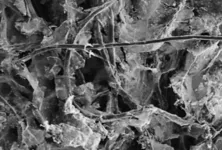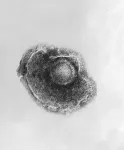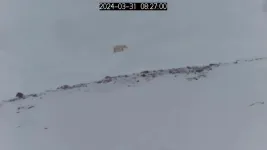(Press-News.org) In the rapidly developing contest between human creativity and artificial intelligence algorithms, professional artists still have an edge in producing more creative AI-assisted artwork than the AI programs themselves or novice artists, according to research published by the American Psychological Association.
The rapid advancement of AI raises some existential questions about the nature of creativity, said lead researcher Paul Seli, PhD, an assistant professor of psychology and neuroscience at Duke University.
“Creativity has long been considered a uniquely human ability that is tied to personal experiences, emotions and the drive to communicate meaning,” he said. “But now that AI can generate complex, aesthetically compelling artwork, we have to ask if human creativity still holds a distinct edge or is AI fundamentally changing the way we think about creative expression?”
At least for now, professional artists still have the upper hand, according to the study findings, which were published online in Psychology of Aesthetics, Creativity, and the Arts.
The researchers selected 15 professional artists with more than five years of experience and 15 people with little or no artistic training. All of the participants wrote prompts of up to 15 words each that were entered in the DALL-E 3 AI program to generate artwork images.
The same instructions for creating a prompt also were entered 15 times in the ChatGPT AI program to create prompts that also were used to generate artwork images in DALL-E 3.
Another group of 299 online participants viewed all 45 of the generated artwork images and rated them on creativity. Artwork created with prompts by the professional artists was rated as significantly more creative than the AI-generated artwork, followed by the novice artists' work in last place.
Additional analysis found that the professional artists and the ChatGPT program used more words in their prompts, which could help generate more creative artwork.
The professional artists also used words in their prompts that were significantly higher in semantic distance than ChatGPT, followed by the novice artists. Semantic distance in this study meant the words used in a prompt were not commonly seen as related to each other, and semantic distance has been linked to creativity in previous studies. For example, one prompt from a professional artist stated: “A madman trapped in a straitjacket made of toilet paper.” By contrast, a prompt from a novice artist stated: “A frog using a leaf as an umbrella.”
“Whether AI is truly ‘creative’ depends on how we define creativity,” Seli said. “AI undeniably generates images and other outputs that people perceive as creative. But if creativity is tied to human experience, emotions and intentionality, then AI appears to fall short.”
The professional and novice artists had no experience using AI image generators so their creativity ratings might have been higher if they had more experience with the AI program or had the opportunity to edit their prompts to fine tune the digital images.
While the professional artists fared well in this study, the tables could be turned soon as AI programs advance at exponential rates, Seli said.
“If AI becomes better at understanding artistic intent or mimicking human-like intuition, the gap between AI and professional artists could narrow or even disappear,” he said. “However, it’s possible that the uniquely human aspects of creativity - such as emotional depth and lived experience - will continue to set human artists apart. Whether that distinction matters in the long run remains an open question. Only time will tell.”
Article: “Beyond the Brush: Human Versus AI Creativity in the Realm of Generative Art,” Paul Seli, PhD, Lucas Bellaiche, MA, and Sarah Spooner, BA, Duke University; Anya Ragnhildstveit, MA, University of Cambridge; William Orwig, PhD, Harvard University; and Nathaniel Barr, PhD, Sheridan College; Psychology of Aesthetics, Creativity, and the Arts, published online Feb. 27, 2025.
Contact: Paul Seli, PhD, may be contacted at paul.seli@duke.edu.
The American Psychological Association, in Washington, D.C., is the largest scientific and professional organization representing psychology in the United States. APA’s membership includes 173,000 researchers, educators, clinicians, consultants and students. Through its divisions in 54 subfields of psychology and affiliations with 60 state, territorial and Canadian provincial associations, APA works to advance the creation, communication and application of psychological knowledge to benefit society and improve lives.
END
Professional artists viewed as more creative than AI programs
People prefer artwork generated from prompts by experienced artists, study finds
2025-02-27
ELSE PRESS RELEASES FROM THIS DATE:
Closing the gaps — MXene-coating filters can enhance performance and reusability
2025-02-27
Despite improvements to air filtration technology in the aftermath of the COVID-19 pandemic, some of the smallest particles — those of automobile and factory emissions — can still make their way through less efficient, but common filters. An interdisciplinary team of researchers from Drexel University’s College of Engineering have introduced a new way to improve textile-based filters by coating them with a type of two-dimensional nanomaterial called MXene.
Recently published in C Journal ...
Digital Science adds AI-powered summaries to Symplectic Elements to drive research discoverability
2025-02-27
Digital Science has today announced new enhancements to Symplectic Elements, which will now offer the ability to embed AI-generated summaries for publication abstracts within a researcher’s public profile.
Symplectic Elements, a leading research information management system (RIMS), enables the creation of comprehensive public profiles. These profiles are hosted on sleek, modern, and intuitive online portals that offer advanced search and discovery capabilities while ensuring alignment with organizational branding. Profiles can be made available not only for researchers and faculty but also for ...
Solar technology could meet UK’s electricity needs without sacrificing farmland
2025-02-27
New University of Sheffield research shows that combining solar panels with farming (agrivoltaics) can meet UK solar energy targets without sacrificing agricultural land
The coverage potential for the technology is so high that it could meet UK electricity demand more than four times over
Regions identified for the effective deployment of agrivoltaics include Cambridgeshire, Essex, Lincolnshire, and the broader East and South East of England
The approach counters criticism of traditional solar farms, which are often opposed ...
Study finds aged biomass emissions could pose greater risk to lungs than fresh wildfire smoke
2025-02-27
Biomass burning—whether from wildfires, wood stoves or agricultural fires—sends massive amounts of tiny particles and chemicals into the air. These emissions are not just an environmental issue; they pose serious health risks, especially for our lungs. An Environmental Pollution study, co-authored by Dr. Jason Surratt, a professor in the Department of Chemistry at UNC-Chapel Hill, reveals how two key components of biomass smoke—levoglucosan and 4-nitrocatechol—affect human lung cells. Their findings suggest that aged ...
Four research teams rethink particleboard construction and reuse
2025-02-27
For a few hundred dollars, a bedroom can be refreshed with the latest flat-pack offerings. Wood particleboard furniture is affordable and generally easy to assemble, but particleboard is often held together with formaldehyde-based resins that make it hard or impossible to recycle. Now, with the help of science, old pressed-wood furnishings could be repurposed, and new modular decor could incorporate more environmentally friendly materials. Four articles published in ACS journals reveal how. Reporters can request free access to these papers ...
Deep-learning framework advances tissue analysis in spatial transcriptomics
2025-02-27
Biological tissues are made up of different cell types arranged in specific patterns, which are essential to their proper functioning. Understanding these spatial arrangements is important when studying how cells interact and respond to changes in their environment, as well as the intricacies of pathologies like cancer. Spatial transcriptomics (ST) techniques, which have been rapidly evolving over the past decade, allow scientists to map gene activity within tissues while keeping their structure intact, ...
From dormant to danger: How VZV reactivation is driving CNS infections
2025-02-27
The varicella zoster virus (VZV), an infectious virus from the herpes virus family, is primarily known to cause varicella in children and shingles in adults. But lately, this virus has also been reported to trigger severe complications like central nervous system (CNS) infections. Researchers from Fujita Health University, Japan, conducted a comprehensive study spanning 10 years (2013–2022), to identify the VZV-related infections affecting the CNS. Their study reveals a marked increase in adult VZV-related CNS infections, ...
DNA barcodes narrow down possible sources of introductions of an invasive banana skipper butterfly pest
2025-02-27
CABI has led a team of scientists who have used DNA barcodes to narrow down the possible sources of introductions of an invasive banana skipper butterfly, with implications as to the threat of it spreading to Africa and tropical America.
The banana skipper, Erionota torus Evans (Lepidoptera, Hesperiidae, Hesperiinae, Erionotini) is a South-east Asian pest of banana that, in the last 60 years, has spread to the southern Philippines, Taiwan, Japan, India, Sri Lanka, Mauritius and La Réunion.
The new research, published in the journal CABI Agriculture and Bioscience, analysed a partial library of DNA barcodes from the indigenous and introduced ranges and suggests that aircraft are likely ...
Transforming clinical care for children with rare genetic diseases
2025-02-27
Global partnerships that embed scientific research into clinical care are revolutionising the diagnosis and treatments for children with rare genetic diseases, according to a new report.
The white paper found despite advances in genomic technologies, which can detect rare genetic diseases within days, there remained significant challenges to ensuring this leads to improved child health outcomes. But global collaborations, such as the International Precision Child Health Partnership (IPCHiP), using evidence-based approaches to inform decisions in real-time, are overhauling patient care.
The paper was led by Murdoch Children’s Research Institute (MCRI), The Hospital for Sick ...
Polar bear cubs emerging from their dens for the first time: New study captures rare footage
2025-02-27
Svalbard, Norway – February 27, 2025 – Researchers from Polar Bears International, San Diego Zoo Wildlife Alliance, the Norwegian Polar Institute, and the University of Toronto Scarborough reveal the first detailed look at polar bear cubs emerging from their dens, captured through nearly a decade of remote camera footage in Svalbard, Norway. This research, published today on International Polar Bear Day in the Journal of Wildlife Management, marks the first combination of satellite tracking collars with remote camera traps to answer ...
LAST 30 PRESS RELEASES:
Norbert Holtkamp appointed director of Fermi National Accelerator Laboratory
New agentic AI platform accelerates advanced optics design
Biologists discover neurons use physical signals — not electricity — to stabilize communication
Researchers discover that a hormone can access the brain by hitchhiking
University of Oklahoma researcher awarded funding to pursue AI-powered material design
Exploring how the visual system recovers following injury
Support for parents with infants at pediatric check-ups leads to better reading and math skills in elementary school
Kids’ behavioral health is a growing share of family health costs
Day & night: Cancer disrupts the brain’s natural rhythm
COVID-19 vaccination significantly reduces risk to pregnant women and baby
The role of vaccination in maternal and perinatal outcomes associated with COVID-19 in pregnancy
Mayo Clinic smartwatch system helps parents shorten and defuse children's severe tantrums early
Behavioral health spending spikes to 40% of all children’s health expenditures, nearly doubling in a decade
Digital cognitive behavioral treatment for generalized anxiety disorder
Expenditures for pediatric behavioral health care over time and estimated family financial burden
Air conditioning in nursing homes and mortality during extreme heat
The Alps to lose a record number of glaciers in the next decade
What makes a good proton conductor?
New science reporting guide published for journalists in Bulgaria
New international study reveals major survival gaps among children with cancer
New science reporting guide published for journalists in Turkey
Scientists develop a smarter mRNA therapy that knows which cells to target
Neuroanatomy-informed brain–machine hybrid intelligence for robust acoustic target detection
Eight SwRI hydrogen projects funded by ENERGYWERX
The Lundquist Institute and its start-up company Vitalex Biosciences Announces Strategic Advancement of Second-Generation fungal Vaccine VXV-01 through Phase 1 Trials under $40 Million Competitive Con
Fine particles in pollution are associated with early signs of autoimmune disease
Review article | Towards a Global Ground-Based Earth Observatory (GGBEO): Leveraging existing systems and networks
Penn and UMich create world’s smallest programmable, autonomous robots
Cleveland researchers launch first major study to address ‘hidden performance killer’ in athletes
To connect across politics, try saying what you oppose
[Press-News.org] Professional artists viewed as more creative than AI programsPeople prefer artwork generated from prompts by experienced artists, study finds




